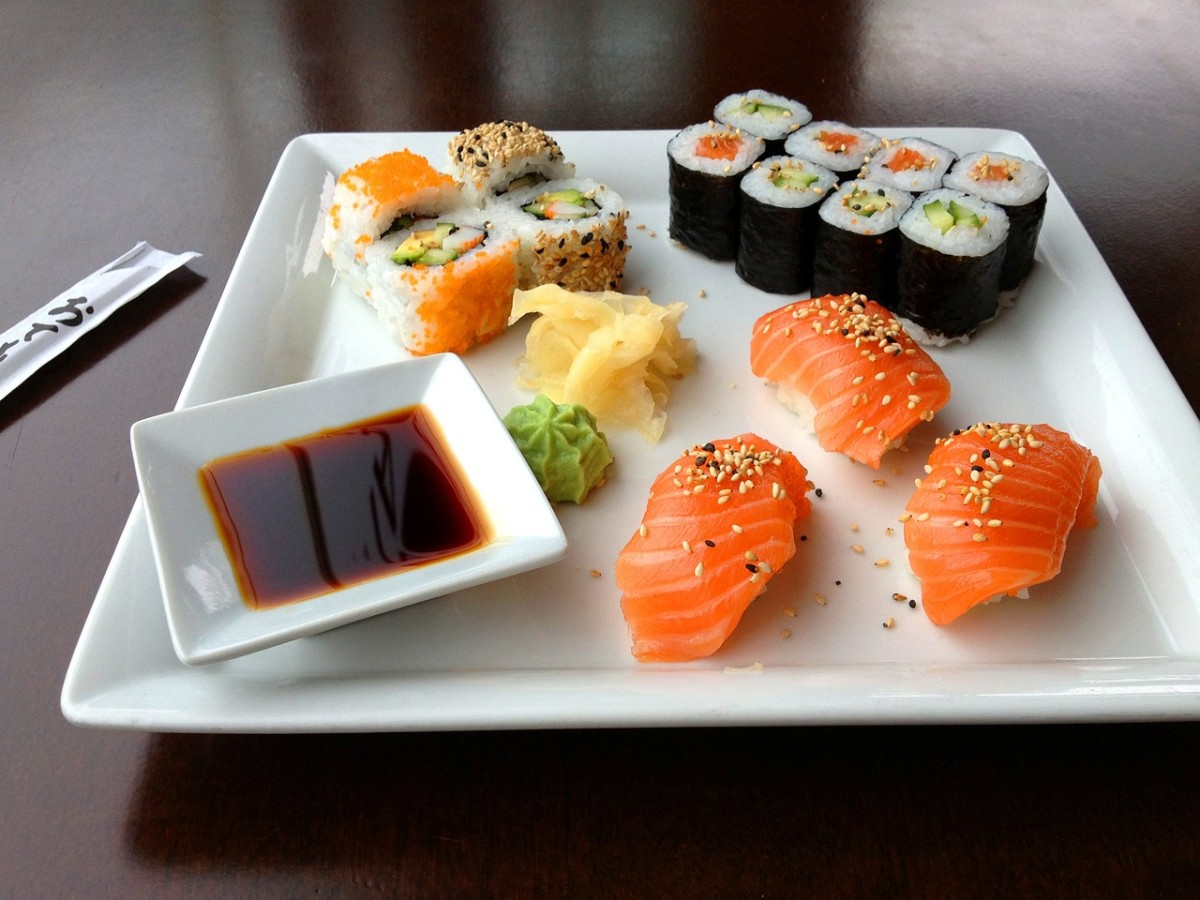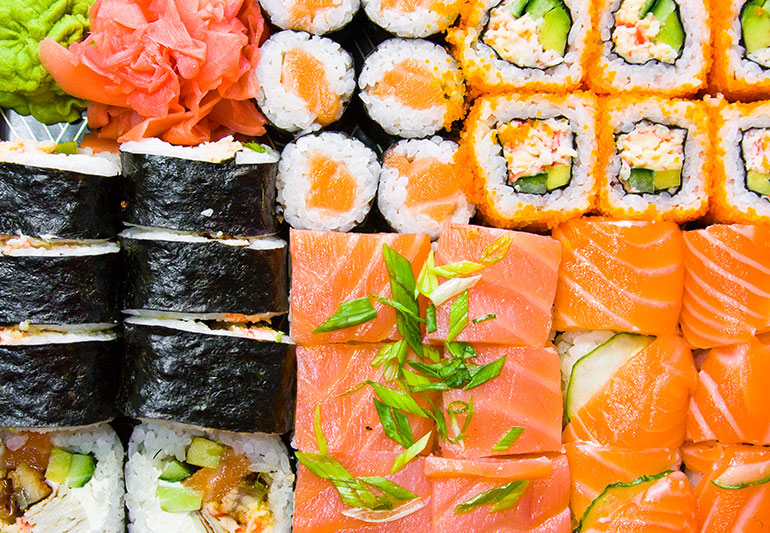
Introduction
According to popular belief, sushi is often associated with raw fish. This misconception has led many people to assume that all sushi is raw. However, the truth is that sushi encompasses a wide variety of ingredients and preparations, not all of which involve raw fish. In this article, we aim to debunk the myth surrounding sushi and clarify the truth about its different components.
Misconception About Sushi And Raw Fish
One of the most common misconceptions about sushi is that it always consists of raw fish. While raw fish, known as sashimi, is indeed a popular ingredient in certain types of sushi, it is by no means the only option. Sushi can also contain cooked fish, seafood, or even vegetarian ingredients like tofu or vegetables. For example, tamago sushi features a sweet rolled omelette as a filling, while tempura sushi includes battered and deep-fried ingredients such as shrimp or vegetables.
The Purpose Of This Article
The purpose of this article is to dispel the notion that all sushi is raw and educate readers on the true diversity of sushi options. By understanding the different types of sushi and ingredients used, readers can make informed choices and explore a wider range of flavors and textures when enjoying this iconic Japanese dish.
In the following sections, we will explore the various types of sushi, both raw and cooked, highlighting their distinct characteristics and cultural significance. We hope that by the end of this article, readers will have a better appreciation for the artistry and complexity of sushi beyond its association with raw fish. So let’s embark on this culinary journey and uncover the truth behind sushi!
History Of Sushi
Origin Of Sushi
Sushi originated in Japan, with the ancient tradition of preserving fish by fermenting it together with rice. The Japanese would pack fish in cooked and seasoned rice, allowing the fermentation process to preserve the fish for extended periods of time, sometimes up to a year. This technique was a key method of food preservation in a time when refrigeration did not exist.
How Sushi Has Evolved Over Time
Over time, sushi evolved from being purely a preservation method to becoming a popular delicacy. The fermentation process was eventually abandoned in favor of using rice vinegar to create the distinct vinegared rice. This led to the creation of nigiri sushi, where a small ball of rice is topped with various ingredients such as fish, seafood, or vegetables.
The popularity of sushi grew during the Edo period (17th to 19th century) when sushi chefs began to experiment with different ingredients and techniques. The Edomae style of sushi emerged, characterized by the use of fresh, high-quality fish caught in Tokyo Bay. This style laid the foundation for the sushi that is popular today.
In the 20th century, sushi gained international recognition and popularity outside of Japan. It was introduced to the United States in the mid-1900s and quickly became a trendy and sought-after cuisine. As sushi started to spread globally, variations and adaptations of the original Japanese style emerged, catering to different palates and cultural preferences.
Today, sushi can be found in various forms, ranging from traditional nigiri and maki rolls to more inventive and creative preparations. Sushi has become a global phenomenon, with sushi restaurants and take-out options available in many countries around the world.
In conclusion, sushi has a rich and fascinating history that goes beyond its association with raw fish. It is a versatile and diverse cuisine that offers a wide range of flavors and ingredients. Understanding the origins and evolution of sushi allows us to appreciate and enjoy this iconic Japanese dish in all its forms.
Types Of Sushi
Nigiri Sushi: Raw Fish On Rice
Nigiri sushi is a type of sushi that consists of a small ball of vinegared rice topped with a slice of raw fish or seafood. The fish is usually thinly sliced and carefully placed on top of the rice. Nigiri sushi allows the flavors of the fish to shine, and it is often served with a touch of wasabi and soy sauce for dipping.
Sashimi: Purely Raw Fish
Sashimi is a dish that consists of thinly sliced raw fish or seafood, served without any rice. It is a pure and unadulterated way to enjoy the flavors and textures of fresh fish. Sashimi is often served with soy sauce, wasabi, and pickled ginger on the side to enhance the taste.
Maki Sushi: Variety Of Ingredients Wrapped In Seaweed And Rice
Maki sushi is a type of sushi that is made by rolling various ingredients in a sheet of seaweed (nori) and vinegared rice. The fillings can include raw or cooked fish, seafood, vegetables, and even fruits. The roll is then cut into bite-sized pieces. Maki sushi offers a combination of flavors and textures in each bite and is often served with soy sauce and pickled ginger.
These three types of sushi offer different experiences and flavors. Nigiri sushi focuses on the simplicity and quality of the raw fish, while sashimi allows the fish to take center stage without any rice. Maki sushi, on the other hand, offers a more varied and customizable experience with its combination of ingredients and flavors.
Sushi is not just about raw fish; it is a versatile cuisine that can cater to various preferences and dietary needs. Whether you prefer the delicate flavors of nigiri sushi, the pureness of sashimi, or the diversity of maki rolls, sushi offers something for everyone to enjoy.

Non-raw Sushi Variations
Tempura Sushi: Fried Seafood Or Vegetables
Tempura sushi is a type of sushi that features deep-fried seafood or vegetables. The seafood or vegetables are coated in a light and crispy tempura batter before being fried. This creates a delightful combination of textures, with the crunchy exterior contrasting with the soft rice inside. Common fillings for tempura sushi include shrimp, crab, and different types of vegetables such as sweet potato and zucchini.
California Roll: Cooked Crab Meat And Avocado
The California roll is a popular type of sushi that originated outside of Japan. Instead of raw fish, it typically includes cooked crab meat, cucumber, and avocado. The fillings are rolled inside a sheet of seaweed (nori) along with vinegared rice. The roll is then cut into bite-sized pieces and often garnished with sesame seeds. The California roll offers a milder flavor profile and is a great introduction to sushi for those who are not fans of raw fish.
Inari Sushi: Tofu Pouch Filled With Rice
Inari sushi is a unique type of sushi that features a sweet and tangy tofu pouch filled with vinegared rice. The tofu pouch, known as inari, is made from seasoned and fried tofu skin. It is then filled with a generous portion of rice and sometimes garnished with sesame seeds or other toppings. Inari sushi is a vegetarian-friendly option that provides a delightful combination of sweet and savory flavors.
These non-raw sushi variations offer a wide range of flavors and textures, catering to different preferences and dietary needs. Whether you prefer the crispy and savory tempura sushi, the mild and creamy California roll, or the sweet and tangy inari sushi, there is a sushi variation for everyone to enjoy. So the next time you think of sushi, remember that it’s not just about raw fish, but a diverse and versatile cuisine with endless possibilities.
Benefits Of Raw Fish In Sushi
Nutritional Value Of Raw Fish
Raw fish is a key ingredient in traditional sushi and offers several nutritional benefits. Some of the nutrients found in raw fish include:
- Protein: Raw fish is a rich source of high-quality protein, which is essential for building and repairing tissues, supporting immune function, and maintaining healthy skin, hair, and nails.
- Vitamins and minerals: Raw fish contains several vitamins and minerals, including vitamin D, vitamin B12, iodine, and selenium. These nutrients play important roles in various bodily functions, such as bone health, nerve function, and thyroid function.
- Omega-3 fatty acids: Certain types of raw fish, such as salmon and tuna, are high in omega-3 fatty acids. These healthy fats have been linked to numerous health benefits, including reduced inflammation, improved heart health, and brain development.
Omega-3 Fatty Acids And Other Health Benefits
In addition to the nutritional value of raw fish, sushi made with raw fish can provide specific health benefits, including:
- Heart health: The omega-3 fatty acids found in raw fish have been shown to help lower blood pressure, reduce triglyceride levels, and reduce the risk of heart disease and stroke.
- Brain function: Omega-3 fatty acids are also important for brain health and development, particularly in infants and young children. Consuming raw fish can support cognitive function and may help reduce the risk of age-related cognitive decline.
- Anti-inflammatory properties: The omega-3 fatty acids in raw fish have anti-inflammatory properties, which can help reduce inflammation in the body and alleviate symptoms of conditions like arthritis and inflammatory bowel disease.
- Weight management: Raw fish is generally low in calories and fat, making it a healthier choice for those watching their weight. It can be a satisfying and nutrient-dense option for a balanced meal.
It’s worth noting that while raw fish in sushi can offer these benefits, it’s important to ensure that the fish is sourced from reputable suppliers and handled properly to minimize the risk of foodborne illnesses. Pregnant women, young children, and individuals with compromised immune systems should exercise caution and consult with a healthcare professional before consuming raw fish.
Concerns About Raw Fish In Sushi
Risk Of Foodborne Illnesses
Sushi made with raw fish can pose certain risks, primarily due to the potential presence of parasites. The Food and Drug Administration has issued guidelines highlighting that raw fish may harbor parasites, which can cause foodborne illnesses if consumed. It is important to note that these risks are associated with raw fish specifically, and not all types of sushi contain raw fish.
Precautions And Guidelines For Safe Consumption
To minimize the risks associated with raw fish in sushi, food businesses that serve sushi follow strict food safety guidelines for preparation and display. These measures include:
- Sourcing fish from reputable suppliers: It is crucial for sushi establishments to obtain their fish from trusted suppliers who follow proper handling and storage practices.
- Proper handling and storage: Sushi chefs are trained to handle raw fish with care, ensuring proper storage at appropriate temperatures and minimizing the risk of cross-contamination.
- Freezing fish to kill parasites: Freezing raw fish at specific temperatures for a certain period can effectively kill parasites. Many sushi establishments freeze their fish to ensure it is safe for consumption.
- Education and awareness: Sushi chefs and staff are well-educated about the risks and precautions associated with serving raw fish. They are trained in proper hygiene practices and stay updated on food safety guidelines.
- Regular inspections: Food establishments that serve sushi undergo regular inspections by health authorities to ensure compliance with food safety standards.
It is important for individuals, especially those with weakened immune systems, pregnant women, and young children, to exercise caution when consuming raw fish. Consulting with a healthcare professional beforehand can provide personalized advice and guidance regarding the consumption of raw fish.
By following these precautions and guidelines, sushi establishments aim to minimize the risk of foodborne illnesses associated with raw fish in sushi and ensure the safety of their customers.
Sushi Beyond Raw Fish
Vegetarian Sushi Options
Contrary to popular belief, sushi is not limited to raw fish. There are plenty of vegetarian options available for sushi lovers. Vegetable rolls, also known as hosomaki, are a popular choice for those who prefer a plant-based diet. These rolls typically consist of fillings such as cucumber, avocado, carrot, and pickled radish. They are wrapped in a thin sheet of seaweed called nori and served with soy sauce and wasabi. Vegetarian sushi options provide a refreshing and satisfying experience without the need for raw fish.
Cooked Fish And Seafood Variations
If raw fish is not your preference, fear not! Sushi offers a wide variety of cooked fish and seafood options. Cooked fish sushi, known as yakizakana, involves grilling or baking the fish before it is rolled into sushi. This cooking method enhances the flavor and texture of the fish, making it a delicious alternative to raw sushi. Seafood lovers can also enjoy sushi made with cooked shrimp, crab, and octopus. These options provide a unique combination of flavors and textures that are sure to delight your taste buds.
In conclusion, sushi does not exclusively consist of raw fish. There are numerous options available for those who prefer vegetarian or cooked variations. Sushi offers a diverse culinary experience that caters to different taste preferences. Whether you enjoy the traditional raw sushi or prefer vegetarian or cooked options, there is something for everyone to enjoy. So the next time you visit a sushi restaurant, feel free to explore beyond raw fish and discover the various flavors and textures that sushi has to offer.

Sushi Ordering Tips
Communicating Preferences To Sushi Chefs
When ordering sushi, it is important to communicate your preferences to the sushi chefs. They are skilled in preparing various types of sushi and can accommodate your requests. Whether you have dietary restrictions or specific preferences, don’t hesitate to let the chef know. For example, if you have a seafood allergy, inform the chef so they can avoid any cross-contamination. Additionally, if you prefer cooked fish or vegetarian options, kindly convey your preferences so the chef can recommend suitable sushi choices.
Understanding Sushi Menu Terminology
Reading a sushi menu can be overwhelming, especially if you are unfamiliar with the terminology. To make the ordering process easier, familiarize yourself with some common sushi terms. Here are a few examples:
| Sushi Term | Meaning |
|---|---|
| Nigiri | Slices of raw fish or seafood on a bed of rice |
| Maki | Seaweed-wrapped sushi rolls with various fillings |
| Sashimi | Slices of raw fish or seafood served without rice |
| Tempura | Deep-fried battered seafood or vegetables |
| Unagi | Grilled freshwater eel |
By understanding these terms, you can confidently navigate a sushi menu and make informed decisions. If you are unsure about any terms or ingredients, don’t hesitate to ask the sushi chef for clarification. They will be more than happy to assist you in finding the perfect sushi options that suit your taste.
Sushi Ordering Tips
Communicating Preferences To Sushi Chefs
To make the most out of your sushi dining experience, it is essential to communicate your preferences to the sushi chefs. They possess extensive knowledge and skills in preparing a wide range of sushi dishes and can accommodate your requests. Whether you have dietary restrictions or specific preferences, don’t be afraid to inform the chef. For example, if you have a seafood allergy, kindly let the chef know so they can ensure there is no cross-contamination. Additionally, if you prefer cooked fish or vegetarian options, communicate your preferences so the chef can recommend suitable sushi choices.
Understanding Sushi Menu Terminology
If you find yourself overwhelmed by the unfamiliar terms on a sushi menu, don’t worry. Familiarizing yourself with some common sushi terms can make the ordering process much easier. Here are a few examples:
| Sushi Term | Meaning |
|---|---|
| Nigiri | Slices of raw fish or seafood on a bed of rice |
| Maki | Seaweed-wrapped sushi rolls with various fillings |
| Sashimi | Slices of raw fish or seafood served without rice |
| Tempura | Deep-fried battered seafood or vegetables |
| Unagi | Grilled freshwater eel |
By familiarizing yourself with these terms, you can confidently navigate a sushi menu and make informed decisions. If you come across any terms or ingredients that you’re unsure about, feel free to ask the sushi chef for clarification. They will be more than happy to assist you in finding the perfect sushi options that suit your taste.
Conclusion
Dispelling The Myth About Sushi And Raw Fish
Despite the common misconception that all sushi is raw, this is not entirely true. While raw fish is a popular ingredient in sushi, there are also options that feature cooked fish, seafood, or even vegetarian fillings. It’s important to understand that sushi refers to the vinegared rice used as a base for various toppings and fillings.
Appreciating The Diversity Of Sushi Options
Sushi is a versatile and diverse cuisine that offers a wide range of flavors and textures. Whether you enjoy the delicate flavor of raw fish in nigiri or the delightful combination of ingredients in maki rolls, there is something for everyone. By exploring the different types of sushi available, you can discover new and exciting flavors that go beyond the misconception that all sushi is raw.
So the next time you dine at a sushi restaurant, remember that there is a sushi dish to suit every preference, whether you prefer raw fish or cooked options. Don’t be afraid to communicate your preferences to the sushi chef and explore the diverse and delicious world of sushi.
Frequently Asked Questions: Is Sushi a Raw Fish?
Clarifying the Raw Fish Dilemma in Sushi
- Is sushi always made with raw fish?
No, sushi does not always include raw fish. While some types of sushi, like sashimi, nigiri, and some rolls, use raw fish as a primary ingredient, there are various sushi options that contain cooked fish, vegetables, or even no fish at all. - What is sashimi then?
Sashimi refers to thin slices of raw fish or seafood, served without rice or other ingredients. Unlike sushi, which features fish nestled on vinegared rice, sashimi is considered a separate dish where the focus is purely on the quality and flavor of the raw fish. - What’s the difference between sushi and sashimi?
The key distinction between sushi and sashimi lies in their composition. Sushi incorporates vinegared rice, while sashimi consists solely of thinly sliced raw fish without any rice. Sushi is often more flavorful, as it combines different ingredients and textures for a well-rounded culinary experience. - Are there other options for non-fish eaters?
Absolutely! Sushi restaurants offer a variety of options to cater to non-fish eaters. Vegetarian sushi rolls, also known as makizushi, are prepared with ingredients like cucumber, avocado, carrot, and other vegetables. In addition, you can find sushi variations with cooked seafood or even tofu, providing ample options to suit different dietary preferences. - Do all sushi rolls contain raw fish?
No, not all sushi rolls contain raw fish. In fact, many popular sushi rolls, such as California rolls or tempura rolls, include cooked ingredients such as cooked crabmeat, shrimp tempura, or grilled eel. These rolls are often enjoyed by those who prefer their seafood cooked or are just starting to explore sushi. - Is raw fish safe to eat in sushi?
When it comes to consuming raw fish, it’s essential to ensure that it’s sourced from reputable suppliers and handled with proper food safety practices. Fresh, high-quality fish that has been properly stored and prepared poses minimal health risks. Restaurants that adhere to stringent sanitation guidelines reduce the likelihood of foodborne illness, providing safe raw fish options for sushi lovers. - Are there any health benefits to eating sushi with raw fish?
Raw fish used in sushi, particularly fatty fish like salmon or tuna, can be a good source of omega-3 fatty acids, which are known for their heart-healthy properties. However, it’s important to maintain a balanced diet and consume sushi in moderation, as excessive consumption of raw fish may expose you to potential contaminants or excess mercury levels.
In summary, sushi is not always made with raw fish. Sashimi is the dish that primarily consists of thin slices of raw fish, while sushi incorporates vinegared rice and can feature cooked or raw fish, vegetables, or even no fish at all. Sushi restaurants offer a wide range of options, including vegetarian rolls and rolls with cooked seafood, to cater to different preferences. When consuming raw fish, ensure it’s from reputable sources and handled properly while considering your overall diet and health.

Our restaurant focuses on providing fresh, new, and cultural dishes to satisfy our customers! All of our dishes are made with the freshest ingredients and with the highest quality spices. We mainly focus on our presentation as well as our flavors. Our main ingredients are fresh meat, seafood, fruits, and vegetables. Some of our Chinese dishes are more raw and pure, while others are sour and spicy. It all depends on what you enjoy; we have it all.
